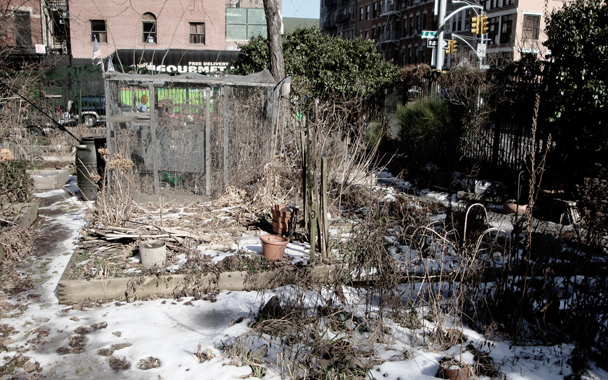Winter is a baleful time for gardeners—their plots are inches deep in snow, deciduous trees remain devoid of leaves, and annuals, trampled into the ground, serve out their final days as undifferentiated mulch. Most green thumbs sit by the fire and dream of spring blossoms, or pore over their computers, planning future plantings.
My community garden in Manhattan’s East Village is no different. Most of my fellow gardeners have abandoned this urban Eden for the season, and the walkways between plots fill with black ice and slush, making a stroll difficult. Yet winter holds an austere beauty, and the lack of visitors, other than furtive squirrels and feral cats, means that I can be alone with my thoughts during my frequent winter sojourns to the garden.
But solitude is not my principal reason for visiting. I’ve learned that, despite their appearance, some plants are still alive. Herbs, in particular, continue to grow slowly, often poking up through the snow. They’re clearly still photosynthesizing the sun’s wan rays, and they constitute little islands of green among all the dead foliage. Rather than spending $4 for a few flavorless sprigs in my local grocery, I’ve learned to continue gathering herbs all winter long.
Herbs, I’ve discovered, are tough. With every hard freeze they die off, then spring back to life. Many are well equipped to weather winter: Sage has thick, leathery leaves, while rosemary and lavender have fleshy needles that expose minimal surface area to the cold. Chives die, then shoot up again with every slight thaw. Clumps of thyme and oregano remain moribund, but deep within their decaying masses, a few green leaves still can be found.
Like stressed grape vines in the summer heat, cold-weather herbs seem to put more concentrated energy into growing, and their pungency outstrips that of summer herbs. I drop them into hearty winter stews, use them in salad dressings, and deploy them as garnishes on cheese and charcuterie platters, where their aroma adds to the pleasure of sampling different meats and cheeses. I even fry sage to crispness in olive oil and shake on some sea salt as a reminder of summers in Italy.
But most of all, I love collecting winter herbs because they represent a little handful of spring in winter’s cold depths.




 Pinterest
Pinterest


